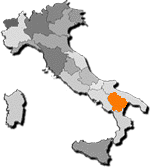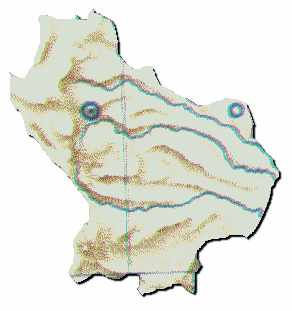 |
BASILICATA |
 Back to Italy |
| Provinces - This region has 2
provinces: Matera and Potenza Chief town - Potenza Surface - kmq 9.992 National Parks - National Park of Pollino (1923)  Russian Version |
 |
|
|
||
 |
BASILICATA |
 Back to Italy |
| Provinces - This region has 2
provinces: Matera and Potenza Chief town - Potenza Surface - kmq 9.992 National Parks - National Park of Pollino (1923)  Russian Version |
 |
|
|
||
 |
Origin of the Name |
| Reliefs - Passes - Coasts - Islands | |
| Landscape | |
| Agriculture - Stock-Farm - Fishing | |
| Industry - Tourism | |
| Position and Frontier | |
| Rivers - Lakes | |
| Climate | |
| Population | |
| Communication |
Origin of the name:
Before being conquered by the Romans, this Region was
called Lucania. Subsequently with the August emperor who united it with Bruttium, actually
Calabria, it started to be called Basilicata, which derives from the Greek basilikos
(governor and prince). Later with the conquest of the Norman ones the name remained and
the actual confinements remained the same. In the period that has gone since 1932 at 1947
the Region was renamed Lucania officially. Today the name has returned to Basilicata, but
the inhabitants are called Lucani.
Landscape:
A big part of the territory is mountainous and hilly,
dug from spacious and sinuous valleys up to where they go down to the brief band of
coastal lowland. The mountainous zone introduces each other arid and deprived of
vegetation. In the zones of country there are few isolated houses. The urban
agglomerations are built very distant the one from the other, often above to the big
hills. Even if the Region is bathed from two seas, very great harbors don't exist, as well
as no big urban centers.
Agriculture - Stock-farm -
Fishing:
Agriculture is the principal economic source, but it
produces low incomes. The principal crops are cereals, sugar beets, ulivo, grapevines,
citrus fruits and tobacco. Notable is the production of tomatoes, almonds, strawberries,
walnut-trees and fig trees. The breeding is constituted in the greatest part from the
pastorizia ovina and caprina, of which it is produced a considerable wool quantity and
cheese. Numerous are the swines, while the cattle are more scarce.
Position and Frontier:
The Basilicata finds its confinements to north with
Puglia, to east always with Puglia and Ionian Sea, to south with Calabria and to west with
the Tyrrhenian Sea and Campania.
Rivers - Lakes:
The rivers are all to torrential character. The
principal goes down from the Appennino in the ionic lowland. These are Bradano, Basento,
Agri and Sinni. In some zones there are the gravine, zones in which deep waters dig
crepaccis spioventi. There are some volcanic lakes such as those of Monticchio and the
artificial basins built to regulate the waters of the rivers, for use in the irrigation
and in the production of electric energy. The most important basins are that of Bradano,
of Agri and of Pertusillo.
Climate:
The climate is continental typically, even if the
Region is bathed in the two slopes from the sea; besides being beaten from the southern
current heats that dry up little existing humidity.
Polulation:
The Basilicata is one of the least populated regions in
Italy in as much as its mountainous territory doesn't facilitate the habitation of man.
The dry and unproductive territory has favored the abandonment and the isolation of the
Region. Intense emigration tells us that there are more Lucanis in the world than in
their own country.
Communication:
The Region possesses three railway lines: two pass next
to the coast, while one is crossing the inside part connecting
Taranto-Metaponto-power-Naples. The chief town of Matera is the only one in Italy where
a railway line doesn't pass. The only highway that grazes the territory is that of
the Sun. Some roads were built in the last years and connect a part of the greatest
inhabited zones breaking the isolation.
Web Site designed by MediaSoft - © Copyright 1998-1999 - All rights reserved